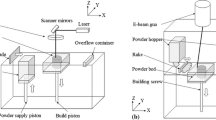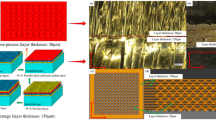Abstract
This paper is focused on double-sided self-pierce riveting (DSSPR) of overlapped sheets made from dissimilar materials with very different mechanical strengths. The methodology draws from previous work on sheets made from similar or identical materials and the extension to dissimilar materials is built-upon a combined experimental and numerical investigation that makes use of AA5754-H111 aluminum and polyvinylchloride sheets. Results show that reengineering of conventional DSSPR by modification of the chamfered rivet angles to account for the different resistances to penetration of the two materials is not effective, because it cannot solve the formation of asymmetric mechanical interlockings with very small undercuts in the harder sheet material. The proposal of an innovative two-stroke DSSPR process in which the tubular rivet is first forced through the harder sheet with the help of a dedicated compression tool, and only subsequently pressed through the softer sheet, proves to be effective in obtaining symmetric joints with good undercuts in both sheets. Destructive shear tests confirm the good performance of the joints produced by means of the new proposed two-stroke DSSPR.










Similar content being viewed by others
References
Meschut G, Janzen V, Olfermann T (2014) Innovative and highly productive joining technologies for multi-material lightweight car body structures. J Mater Eng Perform 25:1515–1523
Bouchard PO, Laurent T, Tollier L (2008) Numerical modeling of self-pierce riveting—from riveting process modeling down to structural analysis. J Mater Process Technol 202:290–300
He X, Baoying X, Kai Z, Gu F, Ball AD (2013) Numerical and experimental investigations of self-piercing riveting. Int J Adv Manuf Technol 69:1–4
Porcaro R, Hanssen AG, Langseth M, Aalberg A (2006) The behaviour of a self-piercing riveted connection under quasi-static loading conditions. Int J Solids Struct 43:5110–5131
He X, Pearson I, Young K (2008) Self-pierce riveting for sheet materials: state-of-the-art. J Mater Process Technol 199:27–36
Li D, Chrysanthou A, Patel I, Williams G (2017) Self-piercing riveting - a review. Int J Adv Manuf Technol 92:1777–1824
Kato K, Okamoto M, Yasuhara T (2001) Method of joining sheets by using new type of rivets. J Mater Process Technol 111:198–203
Huang Z, Xue S, Lai J, Xia L, Zhan J (2014) Self-piercing riveting with inner flange pipe rivet. Proced Eng 81:2042–2047
Huang Z, Yao Q, Lai J, Zhao J, Jiang Z (2017) Developing a self-piercing riveting with flange pipe rivet joining aluminum sheets. Int J Adv Manuf Technol 91:2315–2328
Alves LM, Afonso RM, Martins PAF (2020) Double-sided self-pierce riveting. Int J Adv Manuf Technol 108:1541–1549
Alves LM, Afonso RM, Martins PAF (2021) Double-sided self-pierce riveting of polymer sheets. J Adv Join Proc 3:100051
Nielsen CV, Zhang W, Alves LM, Bay N, Martins PAF (2013) Coupled finite element flow formulation. In: Davim JP (ed) Modelling of thermo-electro-mechanical manufacturing processes with applications in metal forming and resistance welding. Springer, New York. https://doi.org/10.1007/978-1-4471-4643-8_3
Nielsen CV, Martins PAF (2021) Finite element simulation: a user’s perspective. In: Metal forming: formability, simulation and tool design. Academic Press, London. https://doi.org/10.1016/B978-0-323-85255-5.00011-X
Acknowledgments
The authors would like to thank the support provided by Fundação para a Ciência e a Tecnologia of Portugal and IDMEC under LAETA-UIDB/50022/2020.
Availability of data and material
The authors confirm that the data and material supporting the findings of this work are available within the article.
Funding
This work was supported by Fundação para a Ciência e a Tecnologia of Portugal and IDMEC under LAETA-UIDB/50022/2020.
Author information
Authors and Affiliations
Contributions
Experimentation, Luis M. Alves, Rafael M. Afonso, Patric T. Pereira; numerical modeling, Luis M. Alves, Rafael M. Afonso, Patric T. Pereira, Paulo A.F. Martins; writing-original draft preparation, Paulo A.F. Martins; writing-review and editing, Luis M. Alves, Rafael M. Afonso, Paulo A.F. Martins; coordination, Paulo A.F. Martins.
Corresponding author
Ethics declarations
Ethics approval
The article follows the guidelines of the Committee on Publication Ethics (COPE) and involves no studies on human or animal subjects.
Consent to participate
Not applicable. The article involves no studies on humans.
Consent for publication
Not applicable. The article involves no studies on humans.
Competing interests
The authors declare no competing interests.
Additional information
Publisher’s note
Springer Nature remains neutral with regard to jurisdictional claims in published maps and institutional affiliations.
Rights and permissions
About this article
Cite this article
Alves, L.M., Afonso, R.M., Pereira, P.T. et al. Double-sided self-pierce riveting of dissimilar materials. Int J Adv Manuf Technol 115, 3679–3687 (2021). https://doi.org/10.1007/s00170-021-07426-3
Received:
Accepted:
Published:
Issue Date:
DOI: https://doi.org/10.1007/s00170-021-07426-3




